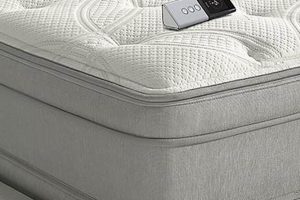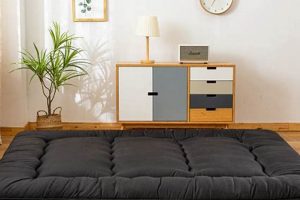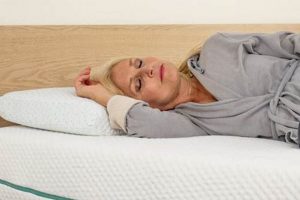A lightweight sleeping solution designed for backpacking and camping, these inflatable pads prioritize minimal weight and pack size. Constructed from durable, lightweight fabrics, they often utilize baffled internal structures for support and insulation. For example, a typical model might weigh under a pound and compress to the size of a water bottle.
Minimizing pack weight enhances mobility and reduces fatigue during extended backcountry trips. These pads offer a critical layer of insulation from the cold ground, improving sleep quality and overall comfort in the outdoors. The evolution of these designs stems from the need to balance comfort and portability in demanding environments, replacing bulkier, heavier alternatives.
The following sections will delve into the key factors to consider when selecting a model, including insulation ratings, packed size, durability, and price. Furthermore, the discussion will extend to the various types available, outlining their respective advantages and disadvantages, and providing guidance on proper care and maintenance to maximize lifespan.
Selection and Usage Guidance
Maximizing the performance and lifespan of a lightweight sleeping pad requires careful consideration of several factors. Proper selection and usage habits contribute significantly to overall user satisfaction and long-term value.
Tip 1: Prioritize Insulation Value (R-value): Evaluate the expected ambient temperatures of intended use. A higher R-value indicates greater insulation and suitability for colder conditions. Select a pad with an R-value appropriate for the coldest anticipated temperatures.
Tip 2: Consider Pad Thickness and Support: Thicker pads generally provide greater cushioning and comfort, but may also increase weight and packed size. Evaluate personal comfort preferences and balance them against weight constraints.
Tip 3: Choose the Appropriate Pad Type: Self-inflating pads offer a balance of comfort and convenience, while air pads are typically lighter and more compact. Foam pads are durable and reliable, but often less comfortable and bulkier. Select the pad type best suited to the intended activity and personal needs.
Tip 4: Protect Against Punctures: Use a groundsheet or tent footprint to protect the pad from sharp objects. Avoid placing the pad directly on rough or abrasive surfaces. Carry a repair kit for field repairs of minor punctures or tears.
Tip 5: Inflate to the Correct Pressure: Over-inflation can stress seams and increase the risk of damage. Inflate the pad to a firm, but not overly taut, pressure. Refer to the manufacturer’s recommendations for optimal inflation levels.
Tip 6: Store Properly When Not in Use: Ensure the pad is completely dry before storing it to prevent mold or mildew growth. Store the pad unrolled or loosely rolled in a cool, dry place away from direct sunlight. Avoid storing the pad compressed for extended periods.
Tip 7: Clean Regularly: Wipe down the pad with a damp cloth and mild soap after each use to remove dirt and debris. Allow the pad to air dry completely before storing.
Adhering to these guidelines will contribute to extended product lifespan, optimized performance, and enhanced comfort during backcountry adventures.
The subsequent sections will offer a detailed comparison of popular models and provide further insights into advanced repair techniques.
1. Weight Optimization
Weight optimization is a foundational principle in the design and manufacture of ultralight sleeping mattresses. It dictates the selection of materials, construction techniques, and overall design philosophy. The primary goal is to minimize the product’s mass without compromising essential performance characteristics such as insulation and durability. A reduction in weight directly translates to a lighter pack, enhancing mobility and reducing fatigue for backpackers and mountaineers. For instance, swapping a traditional sleeping pad for an ultralight model can save upwards of a pound or more, a significant difference over multiple days of hiking.
Achieving optimal weight requires a careful balancing act. Manufacturers often employ lightweight fabrics like ripstop nylon or polyester with minimal denier counts. Internal baffling structures are designed to provide support and insulation with the least amount of material possible. Inflation systems are also streamlined to reduce weight, often opting for manually operated pumps or integrated inflation sacks rather than heavier, battery-powered options. Examples include models utilizing advanced welding techniques to eliminate excess material in seams, and designs incorporating variable thickness fabrics to reinforce high-stress areas without adding unnecessary weight elsewhere.
In conclusion, weight optimization is not merely a design choice but a defining characteristic of the ultralight sleeping mattress category. The pursuit of minimal weight drives innovation in materials science and engineering, ultimately benefiting end-users by enabling them to carry lighter loads and travel further with greater ease. However, it is important to acknowledge that aggressive weight reduction can present challenges in terms of durability and long-term reliability, necessitating careful consideration of the intended use case and environmental conditions.
2. Pack Size
Pack size constitutes a critical determinant in the utility of any ultralight sleeping mattress, particularly for applications where space constraints are paramount. Its impact extends beyond mere convenience, affecting load distribution, available space for other essential gear, and overall mobility.
- Compressed Volume and Dimensions
The compressed volume of a sleeping mattress directly influences the available space within a backpack. Measured in liters or cubic inches, this metric reflects the final size after the mattress has been fully deflated and packed. Smaller compressed dimensions allow for greater packing efficiency and enable the use of smaller-volume backpacks, further reducing overall weight. For example, a mattress compressing to the size of a water bottle provides significantly more packing flexibility compared to one requiring the space of a small sleeping bag.
- Material Compressibility
The inherent compressibility of the materials used in construction significantly affects pack size. Fabrics with tighter weaves and greater flexibility, such as certain grades of nylon or polyester, can be compressed more effectively than more rigid or bulky materials. This characteristic is crucial for achieving a minimal packed volume. For instance, a mattress utilizing down insulation will generally compress smaller than one using synthetic fill due to the superior compressibility of down fibers.
- Inflation/Deflation System Efficiency
The design and efficiency of the inflation and deflation system contribute to the final pack size. Systems that allow for rapid and complete deflation facilitate tighter packing and minimize residual air volume. Valves that effectively prevent air from re-entering during the rolling process are also essential. Inefficient valves or systems can result in a larger packed size, negating some of the weight-saving benefits of an ultralight mattress.
- Stuff Sack Design and Material
The design and material of the stuff sack supplied with the sleeping mattress impact the achievable pack size. Stuff sacks constructed from durable, lightweight, and water-resistant materials offer both protection and compression capabilities. Compression straps integrated into the stuff sack can further reduce the packed volume by applying external pressure. A well-designed stuff sack is integral to realizing the full pack size potential of an ultralight sleeping mattress.
In summary, pack size is a multifaceted attribute of ultralight sleeping mattresses, intricately linked to material properties, design features, and intended use. Achieving a minimal pack size necessitates a holistic approach that considers all contributing factors, ensuring that the chosen mattress meets the specific space and weight requirements of the user’s intended activities.
3. Insulation (R-value)
Insulation, quantified by the R-value, is a pivotal consideration when selecting an ultralight sleeping mattress. It directly impacts the user’s thermal comfort and safety in varying environmental conditions. The R-value measures a material’s resistance to heat flow; a higher R-value indicates greater insulation. This is particularly critical in backcountry settings where ground temperatures can significantly lower body temperature, potentially leading to hypothermia.
- R-value and Environmental Suitability
The R-value dictates the suitability of a sleeping mattress for different climates. Mattresses with low R-values (1-3) are generally adequate for warm-weather camping. Moderate R-values (3-5) are appropriate for three-season use, encompassing spring, summer, and fall. High R-values (5+) are designed for cold-weather or winter camping where ground temperatures can be extremely low. For example, an ultralight mattress with an R-value of 2 may be insufficient for overnight trips in the mountains where temperatures can drop below freezing, even during the summer months.
- Materials and Insulation Efficiency
The materials used in an ultralight sleeping mattress significantly influence its R-value. Closed-cell foam, down insulation, and synthetic fills all offer different levels of insulation. Closed-cell foam provides consistent insulation even when wet but can be bulky. Down provides excellent warmth-to-weight ratio but loses its insulating properties when damp. Synthetic fills offer a compromise, maintaining some insulation when wet and compressing more easily than foam. The choice of material directly impacts the mattress’s ability to retain heat and maintain a comfortable sleeping temperature.
- Construction Techniques and Heat Retention
Construction techniques, such as baffled chambers and reflective layers, can enhance the R-value of an ultralight sleeping mattress. Baffled chambers minimize convective heat loss by restricting air movement within the mattress. Reflective layers, often made of thin metallic films, reflect radiant heat back towards the user, increasing warmth. These techniques allow manufacturers to achieve higher R-values without significantly increasing weight or bulk. For instance, a mattress with a reflective layer may provide the same level of warmth as a thicker, heavier mattress without such a feature.
- Compromises between Weight and Insulation
Achieving a high R-value in an ultralight sleeping mattress often involves trade-offs. Increasing insulation typically necessitates adding more material, which increases weight and pack size. Manufacturers must carefully balance insulation performance with weight and compressibility to meet the demands of ultralight backpacking. Some compromises include using thinner fabrics in areas less prone to heat loss or employing hybrid designs that combine different insulation materials. The selection process requires careful consideration of the intended use case and the user’s tolerance for weight versus warmth.
The R-value is thus a critical parameter to consider when selecting an ultralight sleeping mattress. Choosing a mattress with an appropriate R-value ensures adequate thermal protection, contributing to a safer and more comfortable outdoor experience. The interplay between R-value, materials, construction, and weight represents a fundamental aspect of ultralight sleeping mattress design and performance.
4. Durability
Durability in ultralight sleeping mattresses presents a significant engineering challenge. The pursuit of minimal weight often necessitates the use of thinner, lighter materials, which inherently possess reduced resistance to abrasion, punctures, and general wear and tear. A direct consequence of prioritizing weight reduction is a potential compromise in the product’s lifespan. For example, a mattress constructed with 20D nylon will be considerably lighter than one using 75D polyester but will also be more susceptible to damage from rough ground surfaces or accidental contact with sharp objects. The absence of robust materials directly correlates with an increased likelihood of air leaks and structural failure.
The importance of durability becomes acutely apparent in remote backcountry environments. A punctured or damaged sleeping mattress can significantly impact sleep quality, potentially leading to exhaustion and impaired decision-making. Furthermore, repairs in the field are often challenging, requiring specialized tools and expertise. Consider a scenario where a thru-hiker, miles from civilization, experiences a catastrophic failure of their mattress due to a small tear; the resulting lack of sleep and insulation can compromise their safety and ability to complete their journey. The practical significance of understanding the trade-offs between weight and durability lies in making informed purchasing decisions and adopting preventative measures to mitigate potential damage. Employing a groundsheet, carefully selecting campsites, and carrying a repair kit are essential practices for prolonging the lifespan of an ultralight sleeping mattress.
In conclusion, while weight is a paramount consideration in the ultralight sleeping mattress category, durability remains a critical factor influencing long-term performance and reliability. The selection of an appropriate model requires a careful assessment of the intended use environment and a realistic understanding of the inherent limitations of ultralight materials. Balancing the desire for minimal weight with the need for sufficient durability is essential for ensuring a safe and comfortable experience in the backcountry. The development of innovative materials and construction techniques that enhance both weight reduction and durability represents an ongoing challenge and area of active research within the outdoor gear industry.
5. Comfort
Comfort, as a component of an ultralight sleeping mattress, directly influences sleep quality and subsequent recovery, significantly impacting physical and mental performance during outdoor activities. The design and materials employed in these mattresses aim to strike a balance between minimal weight and adequate support and cushioning. Inadequate comfort can lead to disrupted sleep, muscle soreness, and increased fatigue, negating the benefits of an ultralight setup. For instance, a thin, uninsulated pad may be lightweight but provides insufficient cushioning on uneven ground, resulting in pressure points and disturbed sleep.
The relationship between mattress design and perceived comfort is complex and multifaceted. Factors such as thickness, surface texture, internal baffling structure, and inflation pressure all contribute to the overall experience. Thicker mattresses generally offer greater cushioning and conform better to body contours, reducing pressure on sensitive areas. Specific examples include models with horizontal baffles which tend to provide more even support compared to vertical baffles. Furthermore, the surface texture influences comfort by affecting friction and skin contact. A smooth surface might be prone to slipping, while a textured surface can enhance grip and reduce skin irritation. Choosing the appropriate design necessitates considering individual sleep preferences and body type.
Ultimately, the integration of comfort into ultralight sleeping mattress design represents a crucial trade-off. Prioritizing weight reduction at the expense of comfort can lead to diminished physical performance and reduced enjoyment of outdoor pursuits. Balancing these competing priorities requires careful evaluation of individual needs and the specific demands of the intended activity. Advances in materials science and design continue to push the boundaries of what is achievable in terms of both weight reduction and comfort, but the fundamental understanding of the impact of comfort on overall experience remains paramount.
6. Inflation System
The inflation system is an integral component of an ultralight sleeping mattress, directly affecting its packability, ease of use, and overall reliability. Its design and functionality are critical considerations, as a poorly designed system can negate the weight savings achieved through lightweight materials and construction. The primary objective is to efficiently inflate and deflate the mattress while minimizing weight and bulk. A direct consequence of a streamlined inflation system is a reduced overall pack volume, a crucial factor for backpackers and mountaineers. For example, mattresses utilizing integrated pump sacks eliminate the need for a separate pump, saving both weight and space within the pack.
Various inflation system types exist, each with distinct advantages and disadvantages. Self-inflating mattresses incorporate open-cell foam that automatically draws in air when the valve is opened. While convenient, these systems tend to be heavier than manually inflated options. Manually inflated mattresses, often using integrated pumps or external inflation sacks, offer greater weight savings but require more effort during setup. The choice of system depends on the user’s prioritization of weight versus convenience. Consider a scenario where a thru-hiker on a multi-day trek prioritizes minimal weight; they might opt for a manually inflated mattress with a lightweight inflation sack despite the added inflation time. Conversely, a weekend camper might prefer the convenience of a self-inflating mattress, even if it adds a few ounces to their pack weight. The efficiency of the valve design is also significant; valves that allow for rapid inflation and deflation contribute to ease of use and reduced setup time in adverse weather conditions.
In conclusion, the inflation system is a fundamental element of an ultralight sleeping mattress. Its impact on packability, ease of use, and overall weight is undeniable. Selecting an appropriate inflation system requires a thorough understanding of the available options and a careful consideration of individual priorities. Innovations in valve design, pump mechanisms, and integrated inflation systems continue to drive improvements in both efficiency and weight reduction, further enhancing the appeal of ultralight sleeping mattresses for outdoor enthusiasts.
Frequently Asked Questions
The following questions address common inquiries and concerns regarding the selection, use, and maintenance of ultralight sleeping mattresses. This information is intended to provide clarity and informed decision-making.
Question 1: How does the R-value of an ultralight sleeping mattress affect its performance in cold weather?
The R-value is a measure of thermal resistance. A higher R-value indicates greater insulation, crucial for mitigating heat loss to the ground in cold weather. Selecting a mattress with an R-value appropriate for anticipated temperatures is essential for preventing hypothermia.
Question 2: What are the primary trade-offs between weight and durability in ultralight sleeping mattresses?
Minimizing weight often involves using thinner, less robust materials, which can compromise resistance to punctures and abrasion. The user must balance the need for a lightweight pack with the risk of damage and potential loss of function in demanding environments.
Question 3: How does the inflation system impact the overall usability of an ultralight sleeping mattress?
The inflation system affects both packability and ease of setup. Efficient inflation and deflation mechanisms contribute to a smaller packed size and faster setup times, particularly important in adverse weather conditions.
Question 4: What factors contribute to the comfort level of an ultralight sleeping mattress?
Mattress thickness, surface texture, and internal baffling structure significantly influence comfort. Adequate cushioning and support are crucial for minimizing pressure points and promoting restful sleep.
Question 5: How can the lifespan of an ultralight sleeping mattress be extended?
Using a groundsheet or tent footprint to protect against punctures, carefully selecting campsites, and storing the mattress properly when not in use are essential practices. Regular cleaning and prompt repair of any damage will also prolong its usability.
Question 6: Are ultralight sleeping mattresses suitable for all types of outdoor activities?
Suitability depends on the specific activity and environmental conditions. While beneficial for backpacking and mountaineering, they may not be ideal for activities where durability is paramount and weight is less of a concern.
Selecting an appropriate ultralight sleeping mattress requires careful consideration of individual needs, environmental factors, and the intended use. Understanding these trade-offs facilitates informed purchasing decisions.
The next section will explore specific models and their respective strengths and weaknesses.
Conclusion
This exploration has illuminated the multifaceted considerations surrounding the selection and utilization of an ultralight sleeping mattress. Key points encompassed weight optimization, pack size reduction, insulation value assessment, durability evaluation, comfort factors, and inflation system analysis. Understanding the trade-offs inherent in each of these aspects is essential for making informed decisions aligned with specific needs and environmental demands.
The ongoing pursuit of innovation in materials and design promises continued advancements in ultralight sleeping mattress technology. Careful consideration of the principles outlined herein will empower individuals to maximize the performance and longevity of their equipment, ensuring a safer and more comfortable experience in the outdoors. Prioritizing informed selection contributes directly to responsible and sustainable engagement with the natural world.







![Top-Rated Best Sleeping Mattress for Camping: [Year] Guide Organic & Natural Mattress Buyer’s Guide: Non-Toxic Sleep Solutions Top-Rated Best Sleeping Mattress for Camping: [Year] Guide | Organic & Natural Mattress Buyer’s Guide: Non-Toxic Sleep Solutions](https://mattressworldpa.com/wp-content/uploads/2025/07/th-1737-300x200.jpg)